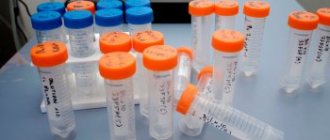After fertilization of the egg, it attaches to the wall of the uterus. At this time, the woman’s body begins to undergo significant changes, which, first of all, relate to changes in hormonal levels. Such transformations are necessary to preserve the life of the embryo, form the placenta and provide it with nutrients and oxygen.
Sometimes, during an examination, the doctor may say that the uterus does not correspond to the gestational age. That is, the reproductive organ, which should gradually increase in size during intrauterine growth of the fetus, deviates from generally accepted parameters up or down.
Hypoplasia, aplasia or small uterus
A small uterus or hypoplasia is a condition in which the small size of the organ leads to dysfunction.
A small uterus can cause infertility or miscarriage. However, this diagnosis requires accurate confirmation. The internal genital organs of the female body are formed at the end of the 1st - beginning of the 2nd trimester. It is believed that at this time the body goes through a critical period of development. Another critical period of development of the body occurs at the age of 11-16 years. Violations that occur during critical periods will affect the entire future life of a person.
If during the first critical period there are disturbances in the growth of the internal genital organs, this can later lead to uterine aplasia. Aplasia or embryonic uterus is a condition in which in a woman of reproductive age the size of the uterus is comparable to the size of the uterus of a newborn child. In severe cases, the uterus may be absent.
Disturbances in the growth and development of the internal genital organs during puberty can lead to uterine hypoplasia. In this case, a small uterus is observed, and underdevelopment of the fallopian tubes, ovaries, and external genitalia is possible.
There is a dependence of function on structure, which means that a small uterus can cause infertility or termination of pregnancy in the early stages. If a woman has a small uterus, its size may not correspond to the norm necessary for a physiological pregnancy.
Infections, hormonal disorders, lack of nutrients and minerals, stress, excessive physical activity, lack of rest and sleep, serious illnesses during a critical period lead to disruption of the growth and development of the entire body.
Often this diagnosis is made on the basis of ultrasound of the pelvic organs. The normal dimensions of the uterus are: length 7
Source
Results of the main question
When the belly begins to grow during pregnancy is perhaps the main question of all mothers, and especially those who are planning to become one for the first time. After all, the feeling that a little life has arisen in you is disturbing and excites the imagination. Every time the expectant mother wonders if this is true? Of course, along with disbelief, such happiness raises another important problem: how to understand whether everything is fine with the baby. Naturally, the growth of the womb is an individual matter. On numerous Internet forums there are a lot of stories from experienced parents that it develops very early or was not noticeable at all, until childbirth. Yes, all such cases do exist, but very rarely.
Claims that roundness can be seen already in the first trimester are incorrect. Only for the reason that the uterus is actively growing at 16 weeks, and at 20 weeks this will be noticed not only by the woman herself, but also by those around her. Doctors rely on their research on this matter. Around 1.5 - 2 months, a woman registers with the antenatal clinic; from this time, the gynecologist measures the waist circumference during each appointment and monitors the growth and development of the baby. All data is systematically entered into the personal card of the expectant mother. Of course, waist circumference is not constant; it depends on many factors. All the beauties, on the eve of important events in their lives, are looking forward to the appearance of a round ball. But gynecologists warn that its large size in the second trimester is not always good. Development larger than the required size can lead to uterine tone. Due to accelerated development, stretch marks appear, which are extremely difficult to cope with. So experts advise maintaining the heaviness with a bandage, and also not overeating. Then, after giving birth, you can easily restore your previous forms.
The uterus is larger than the gestational age in the early stages
The uterus does not correspond to the gestational age
The gestational age in the first trimester is determined by the size of the uterus. Afterwards, the height of the uterine fundus above the womb is measured, which in turn must correspond to a certain period. If the uterus does not correspond to the gestational age, then there are reasons for this.
If the height of the uterine fundus does not correspond, for example, it is less, then this indicates the presence of a reason that delays the development of the fetus. The reasons for this are varied, but the most common is placental insufficiency.
It also happens the other way around, when the uterus does not correspond to the gestational age, being larger than normal. In many cases, this is evidence that there will be twins - a multiple pregnancy. But if this is not the case, then another sign that may indicate a larger uterus during pregnancy is polyhydramnios.
Polyhydramnios is mainly caused by infection. In this case, microbes multiply very quickly in the uterine endometrium; development can also occur with viruses such as intomegalivarius and herpes. Polyhydramnios also occurs in women who have previously had abortions, or have had spontaneous miscarriages, and the cause may also be cervical insufficiency.
The presence of polyhydramnios can be determined using ultrasound. But this can be determined by the doctor himself, since the uterus is very tense and when one wall of the uterus is pushed, the other side moves.
The formation of polyhydramnios does not pose a threat and is considered normal when it develops gradually. But when it appears suddenly, in a short period of time, it poses a danger. In this case, premature birth is caused. In this case, some kind of fetal anomaly occurs, an acute infection in the uterus, or abnormal development of the membranes. The amniotic sac is rarely punctured to release the amniotic fluid.
Source
Uterus during pregnancy: possible pathologies
- One of the diseases of the uterus during pregnancy is isthmic-cervical insufficiency. The essence of this pathology is that the cervix is not able to contract, it is constantly in an open state and cannot hold the child inside. The baby, falling down, provokes contractions of the walls of the uterus, which leads to spontaneous abortion. There are several reasons for ICN. Sometimes such a disease develops due to a woman’s genetic predisposition, and sometimes hormonal disorders or pathologies of uterine development may serve as prerequisites. It happens that previous injuries, for example, resulting from surgery, abortion, or difficult childbirth, lead to isthmic-cervical insufficiency.
- Endocervicitis is another pathology of the female reproductive system that leads to miscarriage. Endocervicitis is an inflammatory disease of the cervical canal that occurs against the background of infections of viral or bacterial origin. The cause of endocervicitis can be sexually transmitted diseases, various staphylococci, streptococci and even intestinal bacteria. The main symptom of the disease is copious mucous discharge with an unpleasant odor.
- Cervical erosion is another pathological condition of the organ that can complicate the course of pregnancy. Previously, we talked about what the cervix should be like during pregnancy. In a pathological condition caused by erosion, the cervix takes on a red, inflamed appearance. There can be several reasons for erosion: various injuries, damage, inflammation. Often the prerequisites for such a pathology are difficult childbirth or abortion. It happens that cervical erosion goes away on its own after the birth of the child, but in most cases it requires treatment.
- Uterine fibroids are an unpleasant disease that complicates the course of pregnancy. To avoid possible complications, it is better to be examined by a doctor in advance for the presence of such pathologies and eliminate them even before the child is conceived. Uterine fibroids are a tumor that is often accompanied by various inflammations, disruptions in the body’s hormonal system, diseases of the ovaries and mammary glands, and other unpleasant manifestations. If uterine fibroids are poorly located or are quite large in size, they can interfere with the normal course of pregnancy and cause emergency delivery by cesarean section. Trying to save the life and health of the child, doctors remove him from the mother’s womb before the due date, but the premature baby is born weak, some of his organs and systems are not yet properly developed. As a result, such a child may experience certain health problems in the future. The most common cause of fibroids is considered to be a hereditary predisposition. If the tumor is located under the placenta, it increases the risk of spontaneous abortion.
Uterus during pregnancy
The uterus (womb) is a pear-shaped reproductive hollow organ consisting of smooth muscles. Thanks to muscle activity, it is able to stretch and contract. In the last month of pregnancy, the uterus increases 5 times. Its shape and size depend on how the pregnancy progresses. Based on the condition of the uterus, tone and position relative to other organs, one can judge the development of the baby, as well as the threat to his life and development. What should you pay attention to, what symptoms indicate pathology of fetal development, how does the uterus change throughout pregnancy? The answer is given in this article.
What is the uterus like during pregnancy?
The myometrium is the middle, muscular layer of the uterus, which consists of elastic fibers that can contract and stretch. It is this that changes throughout pregnancy, adapting to the size and position of the baby. The myometrium is heterogeneous in structure, which ensures contractility: a powerful vascular layer is responsible for feeding the organ, subserous muscle fibers are located lengthwise and in a circle, and the submucosal layer also consists of longitudinal fibrous formations. The hormones progesterone and estrogen contribute to the elasticity of the uterine walls and the stretching of the myometrium. It increases not only in length, but also in volume, due to which the uterus during pregnancy takes on a round shape instead of a pear-shaped one.
In addition to the myometrium, changes occur in the inner layer lining the uterine cavity - the endometrium. It is a loose mucous surface to which the embryo is attached. During the 1st trimester of pregnancy, the thickness of the endometrium changes from 8-10 mm to 20 mm. Until the placenta is formed, it protects and nourishes the embryo.
The perimeter, or layer made up of connective tissue, also changes. Being a continuation of the urinary p
Source
Development of the uterus
Since this organ increases throughout the entire interesting period, it also undergoes changes along with the fetus:
- The first time of gestation it looks like a pear, but by the end of 2 months it increases significantly, about 3 times and becomes rounded.
- During the second half of the term, when fetal movement during pregnancy begins to be felt, it retains the shape of a ball.
- The beginning of the third trimester, when the belly begins to grow at an accelerated pace during pregnancy, this organ takes on the shape of an egg.
- In a normal unfertilized state, the uterus weighs 50 - 100 grams, but at the end of waiting for the baby, it already weighs about 1000 grams.
- Its volume increases more than 500 times.
- During the period of an interesting position, each muscle fiber lengthens 10 times and thickens about 5 times.
- In terms of its oxygen regime at this time, it becomes on the same level as such important organs as the heart, liver or brain.
- The network of blood vessels increases.
All these parameters can be found out thanks to an external obstetric examination, but in the first days of gestation, while the womb is within the pelvic bones, all its parameters can be found out only through a vaginal examination.
How the uterus changes during pregnancy
For a long 9 months, the uterus will become the home for the unborn baby. Its formation, the comfortable existence of the fetus and mother, and the course of the entire process as a whole depend on it. During early pregnancy, the uterus undergoes changes that are not as noticeable as in subsequent stages. But they play an important role, because they are not only one of the signs of the birth of a new life, but can also warn of potential difficulties that sometimes have to be encountered during the nine months of gestation.
Briefly about the structure of the uterus
To understand how the uterus changes in the early stages of pregnancy, you should know what it is like before it. This organ has the shape of a pear and includes the neck, isthmus and body. The layer that holds the fertilized egg is called the endometrium. In many ways, it ensures that the embryo remains inside, especially at first.
In addition to the endometrium, two more layers are distinguished: the myometrium (muscle base) and the perimeter (the outer part of the uterus). Their integrity and adequate functioning are also necessary for a healthy pregnancy.
Many women would like to know what the uterus looks like in early pregnancy. For a specialist, the appearance of an organ can be one of the signs of the condition. And although upon examination only a part of it called the cervix is visible, and not entirely, but partially, the changes occurring with it will clearly indicate the presence of a new organism in the uterus. Usually the pink shell is made bluish in color. The sign is caused by the flow of a significant volume of blood into this area, as well as the dilation of blood vessels and the appearance of new capillaries necessary to improve oxygen metabolism. All these criteria are important for the healthy development of the embryo. The blueness of the mucosa is noticeable at a very early stage, almost immediately after implantation of the embryo.
Dimensions of the uterus in early pregnancy
Source
Not by days, but by hours
It should be emphasized that during a physiological pregnancy, the woman most often does not feel the growth of the uterus, since the process of enlargement of the uterus occurs gradually and smoothly. At the beginning of pregnancy, a woman may notice unusual sensations in the lower abdomen associated with changes in the structure of the uterine ligaments (they “soften”). With rapid growth of the uterus (for example, with polyhydramnios or multiple pregnancies), with adhesions in the abdominal cavity, with posterior deviation of the uterus (most often the uterus is tilted anteriorly), if there is a scar on the uterus after various operations, pain may occur. It should be remembered that if any pain occurs, you must consult an obstetrician-gynecologist as soon as possible.
Interesting: Is it possible to take laxatives during pregnancy?
Uterus in early pregnancy
One of the most mysterious organs of the female body is the uterus. It is she who, during the nine months of pregnancy, becomes a cozy home for a new person. Just think: in a non-pregnant state, the length of the uterus of an adult woman is on average 5-8 cm, and with the onset of pregnancy it begins to increase and by the end of 9 months reaches such a size that it can accommodate a child 48-52 centimeters long, and also weighing three (and sometimes four and a half!) kilograms. If we take into account the amniotic fluid and the placenta, then it becomes clear: the uterus is the most elastic organ. The average weight of a nulliparous uterus is 40-50 g, and a parous uterus is 80-90 g.
The uterus is located in the pelvic cavity between the bladder and rectum. The fertilized egg enters it, moving along the fallopian tube. It is in the uterus that implantation (attachment) and further development of the embryo occur. It should be noted that the uterus consists of the fundus, body and cervix, the length of which is proportional to the gestational age and averages 3 cm.
If a woman suspects pregnancy or is informed about this by 2 lines on the test, do not postpone a visit to the antenatal clinic. At the first examination, the gynecologist can confirm the presence of an “interesting situation” by some changes in the uterus. Namely, during pregnancy, cyanosis (cyanosis) of the mucous membrane of the vagina and cervix is noted, as well as changes in the size, shape and consistency of the uterus.
What exactly changes in the uterus occur in early pregnancy?
signs of pregnancy by group Therefore, on the eve of such a significant event as pregnancy, she certainly rushes to find out as early as possible that her dream has turned into reality in the literal sense of the word.
But how to determine the first prize? Enlargement of the uterus is noticeable at 5 - 6 weeks of pregnancy. At the same time, its shape changes: from pear-shaped it becomes spherical. By the end of the second month of pregnancy, the uterus increases to the size of a goose egg. The following sign is also very characteristic of early pregnancy: p
Source
Uterus in early pregnancy, what changes are considered normal
Throughout pregnancy, this organ undergoes the greatest modification. Initially, the state of the inner layer in the uterus changes. The gynecologist at the appointment, even without special devices, can see the manifested thickenings and the presence of hyperplasia. This means that epidemics become softer and slipperier.
Other parts of the reproductive organ gradually undergo changes. The uterus in early pregnancy is characterized by the following metamorphoses:
2. The mucous membrane appears to be colored purple, the change is explained by a large influx of blood and the development of blood vessels;
4. From the fifth week, the enlargement of the uterus is already visible, and it first stretches along the front-to-back line, and only after a short interval in the transverse direction;
Not the entire uterus becomes soft; the cervix still becomes quite dense. This situation allows you to bring the fingers of two hands closer to each other; this technique is also called Horwitz-Geghara.
2. Pikachev’s sign, the uterus looks asymmetrical, the fertilized egg can be fixed in one of the branches of the organ, and this side protrudes into a dome-shaped formation;
Pain in the uterus in early pregnancy
Women in the first weeks of pregnancy after conception may feel some discomfort in the lower abdomen, and even cravings, this is due to the following reasons characteristic of the uterus in the early stages:
The bones are affected by internal secretion, namely the hormone relaxin, it makes the substance loose and gives the ability to stretch, all this is aimed at the mobility of the pelvic bones, so often after childbirth the bones of a pregnant woman become somewhat wider than they were before.
What is uterine hypertonicity, why should you beware of it?
I am 16 weeks pregnant and there is no belly. Women expecting a baby are always worried about the question: “When does the belly appear during pregnancy?” If the conception was planned, then the rounded tummy causes delight among future parents. They've been waiting for his appearance since then
If the pain is not accompanied by
Source
How to determine where the growth of the womb originates during pregnancy
In terms of physiology, when the abdomen begins to grow during pregnancy, the second third of the term begins, then the corresponding organ rises above the level of the pubic plexus. Over time, the uterus gradually protrudes forward, causing an increase in the abdominal cavity. It follows from this that rising above the pubic bone, where the belly begins to grow during pregnancy, it noticeably increases due to the actively developing corresponding organ. Already at 15–16 weeks, this organ reaches decent volumes, then the roundness disappears and is visible to others. This is what doctors say: developing from the pubic bone, the uterus actively grows at about 16 weeks, and already at 20 its size is noticeable to everyone around.
Is it dangerous to do an ultrasound in early pregnancy?
Transvaginal ultrasound (ultrasound) is a real chance to evaluate the development of pregnancy in the early stages from a professional point of view. It allows you to identify all sorts of deviations and problems, visually see the fertilized egg, its location in the uterus, as well as a lot of other nuances. As a result of the examination, the doctor can establish an accurate diagnosis if a woman has any problems. Should I do an ultrasound in the early stages of pregnancy? Can it harm the baby? Let's look at all the nuances of the procedure.
When should the first ultrasound be done?
Quite rarely, a woman herself decides to undergo examination. Most likely, she does this due to her worries or inexperience, simply delaying the moment of visiting the doctor. In all other cases, ultrasound of pregnancy in the early stages is prescribed only by a specialist and no earlier than 12-13 weeks. Before this period, the doctor may refer the patient for an unscheduled examination when he has doubts or suspicions of deviations from the normal course of pregnancy. Also, the reason for the analysis may be nagging and aching pain, bleeding, previous miscarriages, frozen pregnancy, or suspected pathologies in the fetus. All this will help you take timely action.
Research at this time is carried out quite rarely. A doctor's suspicion of an ectopic pregnancy may be a harbinger. The mother will also be examined during this period after IVF. Based on the results, the presence of pregnancy, its course, its duration will be accurately determined, and problems will also be identified if the delay in menstruation did not occur due to conception.
The ultrasound specialist can examine the umbilical cord, ear buds and limbs.
The fruit at this period is still very small, only 2-4 mm. However, the Source
Fetal development norms
The size of the fertilized egg, and then the child, is determined using ultrasound; thanks to transvaginal examination, the embryo can be seen at 14–21 days of its development, that is, 1.5 months from the moment of conception.
- At first, the size of the embryo is very small. For example, at 1.5 months from the moment of conception, the size of the fertilized egg corresponds to 2 - 4 mm;
- 2.5 months from the moment of conception, the future baby corresponds to 22 mm;
- The end of the first trimester, the dimensions of the conceived baby are 6 - 7 cm, weight 20 - 25 grams, amniotic fluid volume is about 30 - 40 ml, ultrasound shows that the baby occupies almost all the space;
- The first period of the second trimester is characterized by a sharp increase and gain in the weight of the fetus, when the belly begins to grow during pregnancy, and other organs associated with this process develop accordingly; already at the 16th week, the baby’s size is 12 cm, it weighs 100 grams, the uterus in its parameters corresponds to the term ;
- 5 months, the child increases its volume, when the child begins to move, it reaches 25 - 26 cm and weighs 280 - 300 grams;
- The first period of the third trimester, and the baby’s dimensions are 28 - 30 cm, the baby weighs 700 - 750 grams, no one will doubt your interesting position;
- The 28th week of the child corresponds to 35 cm, and weight 1000 - 1200 g;
- At 32 - the baby reaches 40 - 42 cm in development, and his weight corresponds to 1500 - 1700 grams;
- 36 weeks, the child’s height is 45 – 48 cm, and weight is about 2500 g;
- The last days of gestation, the child, as well as all organs, grow very actively, and the waist circumference actively increases accordingly. By the time of birth, a full-term baby weighs from 2800 to 5000 g, and its height is from 48 to 54 cm.











